![]()

![]()
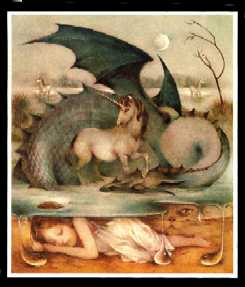 Aelian
said, "They say that there are mountains in the interior regions of India
which are inaccessible to men and therefore full of wild beasts. Among these is
the unicorn, which they call the 'cartazon'. This animal is as large as a
full-grown horse, and it has a mane, tawny hair, feet like those of the
elephant, and the tail of a goat. It is exceedingly swift of foot. Between its
brows there stands a single black horn, not smooth but with certain natural
rings, and tapering to a very sharp point. Of all animals, this one has the most
dissonant voice. With beasts of other species that approach it the 'cartazon' is
gentle, but it fights with those of its own kind, and not only do the males
fight naturally among themselves but they contend even against the females and
push the contest to the death. The animal has great strength of body, and it is
armed besides with an unconquerable horn. It seeks out the most deserted places
and wanders there alone. In the season of rut it grows gentle towards the chosen
female and they pasture side by side, but when this time is over he becomes wild
again and wanders alone. They say that the young ones are sometimes taken to the
king to be exhibited in contests on days of festival, because of their strength,
but no one remembers the capture of a single specimen of mature age."
Aelian
said, "They say that there are mountains in the interior regions of India
which are inaccessible to men and therefore full of wild beasts. Among these is
the unicorn, which they call the 'cartazon'. This animal is as large as a
full-grown horse, and it has a mane, tawny hair, feet like those of the
elephant, and the tail of a goat. It is exceedingly swift of foot. Between its
brows there stands a single black horn, not smooth but with certain natural
rings, and tapering to a very sharp point. Of all animals, this one has the most
dissonant voice. With beasts of other species that approach it the 'cartazon' is
gentle, but it fights with those of its own kind, and not only do the males
fight naturally among themselves but they contend even against the females and
push the contest to the death. The animal has great strength of body, and it is
armed besides with an unconquerable horn. It seeks out the most deserted places
and wanders there alone. In the season of rut it grows gentle towards the chosen
female and they pasture side by side, but when this time is over he becomes wild
again and wanders alone. They say that the young ones are sometimes taken to the
king to be exhibited in contests on days of festival, because of their strength,
but no one remembers the capture of a single specimen of mature age."
 "It
has also been described as having the hind legs of an antelope, the tail of a
lion, and the beard of a goat. Represented in the arts of numerous ancient and
medieval Asian and European cultures, the unicorn may have been created from
distorted reports of rhinoceroses. Ctesias, a Greek physician, about 400 BC
wrote a classic description of the unicorn, calling it an Indian wild ass with a
white body, purple head, and a straight 'cubit-long'* horn with a white base,
black middle, and red tip. He described it as fleet and fierce. The unicorn is
also mentioned in the writings of Aristotle, Pliny, and Aelian." (http://www.oocities.org/Area51/Corridor/1141/ucreature.html)
*A cubit is an old unit of measuring, which is length of the tip of the middle
finger to one's elbow.
"It
has also been described as having the hind legs of an antelope, the tail of a
lion, and the beard of a goat. Represented in the arts of numerous ancient and
medieval Asian and European cultures, the unicorn may have been created from
distorted reports of rhinoceroses. Ctesias, a Greek physician, about 400 BC
wrote a classic description of the unicorn, calling it an Indian wild ass with a
white body, purple head, and a straight 'cubit-long'* horn with a white base,
black middle, and red tip. He described it as fleet and fierce. The unicorn is
also mentioned in the writings of Aristotle, Pliny, and Aelian." (http://www.oocities.org/Area51/Corridor/1141/ucreature.html)
*A cubit is an old unit of measuring, which is length of the tip of the middle
finger to one's elbow.
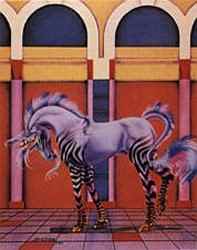 These
beasts from India, Africa or Asia are normally less than the perfect beauty of
European versions to come. The differences are very obvious to detect, even when
the descriptions range very similiar. The Arabian has a long, twisted horn, and
lightly darkened fur. The Oriental has a shorter, crooked horn, dark fur, and a
long 'beard'. The European is light colored with a straight, tightly wound horn
and a flowing mane.
These
beasts from India, Africa or Asia are normally less than the perfect beauty of
European versions to come. The differences are very obvious to detect, even when
the descriptions range very similiar. The Arabian has a long, twisted horn, and
lightly darkened fur. The Oriental has a shorter, crooked horn, dark fur, and a
long 'beard'. The European is light colored with a straight, tightly wound horn
and a flowing mane.
When Marco Polo had journeyed across Asia, he had "returned to Italy to write of a beast with the head of a pig, the body of an elephant, and a single horn growing from its nose." (http://www.oocities.org/Area51/Corridor/4378/legend.html) This may have been the real time n which the idea of the unicorn truly became present in central Europe. And over the years, it became customized to fit the lives and uses of the extremely-religious population.
"A creature imagined nobly as terrible, solitary, with the beauty of power, was transformed under Christian influence into a little goat-like animal eating out of the hand, going to sleep in maidens' laps, and serving as a symbol of virginity. Nietzsche could not have asked for a more brilliant illustration of 'slave mortality'." (Odell Shepard's The Lore of the Unicorn)
 "The
European unicorn took the form of a large, white steed with a flowing white mane
and a tuft of white hair on its chin. In most other respects it was much like an
ordinary horse, except for having white hooves. It most unusual feature, of
course, was the single white spiral horn projecting forward at an upward angle
from its forehead." (http://www.angelfire.com/ar/callisto72/unicorns.html)
"The
European unicorn took the form of a large, white steed with a flowing white mane
and a tuft of white hair on its chin. In most other respects it was much like an
ordinary horse, except for having white hooves. It most unusual feature, of
course, was the single white spiral horn projecting forward at an upward angle
from its forehead." (http://www.angelfire.com/ar/callisto72/unicorns.html)
These horns were quite exceptional, and "have been described as been white, golden or very colorful with red on the top, black on the middle and blue on the base. The eyes have been told to be completely black or bright with a gleaming light. Some reports describe small spots on the base of the neck or even completely black unicorns. The tails have been completely covered with long furs, like horses, or only on its end, like a lion tail." (http://www.oocities.org/Area51/9661/legend.htm)
 These
brilliant horns were more than just for the unicorn's use, according to the
fables of the time period. The could be used to ward off poison, heal stomach
pains, cure epilepsy, and much more. There became, naturally, something very
much to be desired. "Horns of antelopes and rhinoceros, teeth of narvals
and many other things were sold as being unicorn horns, which were believed to
be the center of their power and immortality, giving the owner the same
immortality, the resistance against any poison and even resurrect the
dead." (http://www.oocities.org/Area51/9661/legend.htm)
Photius said, "Those who drink out of these horns, made into drinking
vessels, are not subject, they say, to convulsions or to the holy disease
[epilepsy]. Indeed, they are immune even to poisons if, either before or after
swallowing such, they drink wine, water or anything else from these
beakers."
These
brilliant horns were more than just for the unicorn's use, according to the
fables of the time period. The could be used to ward off poison, heal stomach
pains, cure epilepsy, and much more. There became, naturally, something very
much to be desired. "Horns of antelopes and rhinoceros, teeth of narvals
and many other things were sold as being unicorn horns, which were believed to
be the center of their power and immortality, giving the owner the same
immortality, the resistance against any poison and even resurrect the
dead." (http://www.oocities.org/Area51/9661/legend.htm)
Photius said, "Those who drink out of these horns, made into drinking
vessels, are not subject, they say, to convulsions or to the holy disease
[epilepsy]. Indeed, they are immune even to poisons if, either before or after
swallowing such, they drink wine, water or anything else from these
beakers."
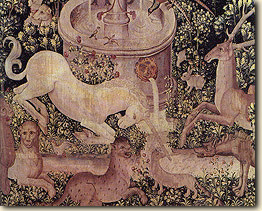 So
how does one catch a unicorn? According to the tales, the unicorn's one weakness
was a pure maiden. If the beast say such a sweet virgin sitting, it would
immediately come and lay in the maiden's lap, instantly becoming tame and open
to attacks by the hunters hiding nearby.
So
how does one catch a unicorn? According to the tales, the unicorn's one weakness
was a pure maiden. If the beast say such a sweet virgin sitting, it would
immediately come and lay in the maiden's lap, instantly becoming tame and open
to attacks by the hunters hiding nearby.
The unicorn has been mentioned in more than oral tradition as being related to the biblical stories and being a religious figure itself.
"In the King James Version of the Bible, there are seven clear referances to the unicorn, all of which occur in the Old Testament. The animal is mentioned twice in the Pentateuch, once in Job, once in Isiah and three times in the Psalms." (Odell Shepard's The Lore of the Unicorn)
"God brought them out of Egypt; he hath as it were strength of the unicorn." -Numbers xxiii. 22.
"His glory is like the firstling of his bullock, and his horns are like the horns of unicorns: with them he shall push the people together to the ends of the earth." -Deuteronomy xxxiii. 17.
"Save me from the lion's mouth; for thou hast heard me from the horns of unicorns." -Psalm xxii. 21.
 "He
maketh them [the cedars of Lebanon] also to skip like a calf; Lebanon and Sirion
like a young unicorn." -Psalm xxix. 6.
"He
maketh them [the cedars of Lebanon] also to skip like a calf; Lebanon and Sirion
like a young unicorn." -Psalm xxix. 6.
"But my horn shall thou exalt like the horn of the unicorn: I shall be anointed with fresh oil." -Psalm xcii. 10.
"And the unicorns shall come doen with them, and the bullocks with their bulls; and their land shall be soaked with blood, and their dust made fat with fatness." -Isaiah xxxiv. 7.
"Will the unicorn be willing to serve thee, or abide in thy crib?
"Canst thou bind the unicorn with his band in the furrow? or will he harrow the valleys after thee?
"Wilt thou trust him because his strength is great? or wilt thou leave to labour to him?
"Wilt thou believe him, that he will bring home thy seed, and gather it into thy barn?" -Job xxxix. 9-12.
In the Bible Dictionary of the King James' Version of the Bible, it describes the unicorn as thus:
"Unicorn: A wild ox, the Bos Prunigenius, now extinct, but once common in Syria. The KJV (King James' Version) rendering is unfortunate, as intended is two-horned."
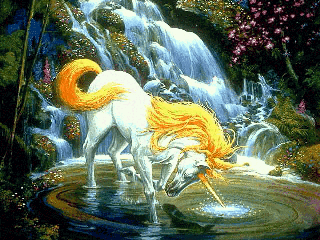 "Some
early translations of the Hebrew scriptures mentioned the unicorn (modern
versions tend to call the same animal a 'wild ox'), and as a biblical beast it
acquired ecclesiastical associations. It represented chastity and purity. Though
it would fight savagely when cornered, it could be tamed by a virgin's
touch." (http://www.oocities.org/Area51/Corridor/1141/ucreature.html)
"Some
early translations of the Hebrew scriptures mentioned the unicorn (modern
versions tend to call the same animal a 'wild ox'), and as a biblical beast it
acquired ecclesiastical associations. It represented chastity and purity. Though
it would fight savagely when cornered, it could be tamed by a virgin's
touch." (http://www.oocities.org/Area51/Corridor/1141/ucreature.html)
As for some more modern ideals of the unicorn, this German folksong, collected by Ludwig Uhland in the early nineteenth century gives a good example of how the unicorn has become a legendary creature of beauty, nobility and power, not to mention perfection.
The Unicorn is noble;
He knows his gentle birth,
He knows that God has chosen him
Above all beasts of earth.
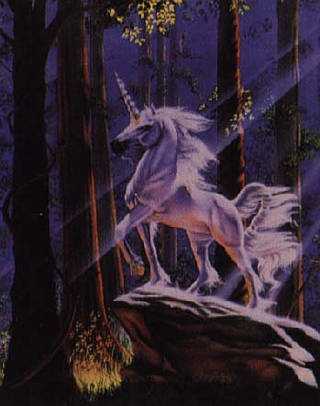 The
Unicorn is noble;
The
Unicorn is noble;
He keeps him safe and high
Upon a narrow path and steep
Climbing to the sky;
And there no man can take him,
He scorns the hunter's dart,
And only a virgin's magic power
Shall tame his haughty heart.
What would be now the state of us
But for this Unicorn,
And what would be the fate of us,
Poor sinners, lost, forlorn?
Oh, may He lead us on and up,
Unworthy though we be,
Into His Father's kingdom,
To dwell eternally'
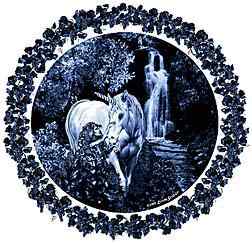 As
you can tell, the unicorn is strongly suggested to be apart of the kingdom of
the Christian God. It is the pureness and sinless creature who has saved the
human race simply by existing on this earth.
As
you can tell, the unicorn is strongly suggested to be apart of the kingdom of
the Christian God. It is the pureness and sinless creature who has saved the
human race simply by existing on this earth.
Since we are on the topic of poetry, tell me, have you heard of this little rhyme?
The lion and the unicorn,
Were fighting for the crown,
The lion beat the unicorn,
All around the town.
Some gave them white bread,
Some gave them brown,
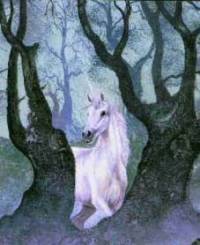 Some
gave them plum cake
Some
gave them plum cake
And drummed them out of town.
The familiar nursery rhyme of the Lion and the Unicorn may represent the relationship between the Scotts and the Englishmen in the past, as they "hate each other by instinct" and "that they never meet without fatal consequences." (Odell Shepard's The Lore of the Unicorn) The British coat of arms at this time has a rampant unicorn and rampant lion, but before having taken over Scotland, it was two rampant lions. The Scottish coat of arms was two unicorns. Upon joining together, their compromise on the coat of arms was one lion and one unicorn.
The relationship between the creatures of the lion and the unicorn as similar to what is explained in the rhyme. This might be in competition for land, as they are both territorial creatures.
The unicorn legends have also spread to the American land masses, especially North America. "The most famous early account though is that of Dr Olfert Dapper in Die Unbekante Neue Welt, published in Amsterdam in 1673, who writes: 'On the Canadian border there are sometimes seen animals resembling horses but with cloven hooves, rough manes, a long straight horn upon its forehead, a curled tail like that of the wild boar, black eyes and a neck like that of the stag. They live in the loneliest wildernesses and are so shy that the males do not even pasture with the females except in the season of rut, when they are not so wild.'" (http://www.oocities.org/Athens/4352/uniamer.htm)
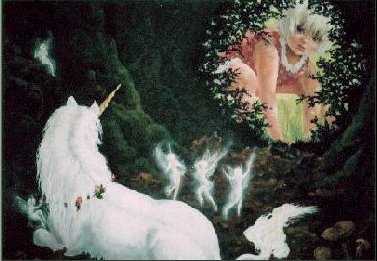 The
strongest belief in modern unicorns lies the realms of faerie, to which the
unicorn has become attached. From a Christian symbol of purity and virginity, it
became a magical example of the power of the Fae in the human world.
The
strongest belief in modern unicorns lies the realms of faerie, to which the
unicorn has become attached. From a Christian symbol of purity and virginity, it
became a magical example of the power of the Fae in the human world.
"The Unicorns were the most recognizable magic the fairies possessed, and they sent them to those worlds where belief in the magic was in danger of failing altogether. After all there has to be some belief in magic - however small - for any world to survive." (Terry Brooks, The Black Unicorn)
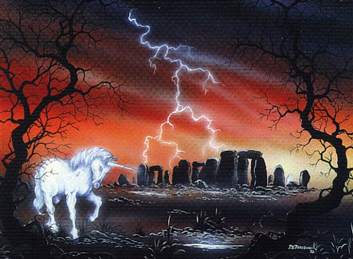
![]()